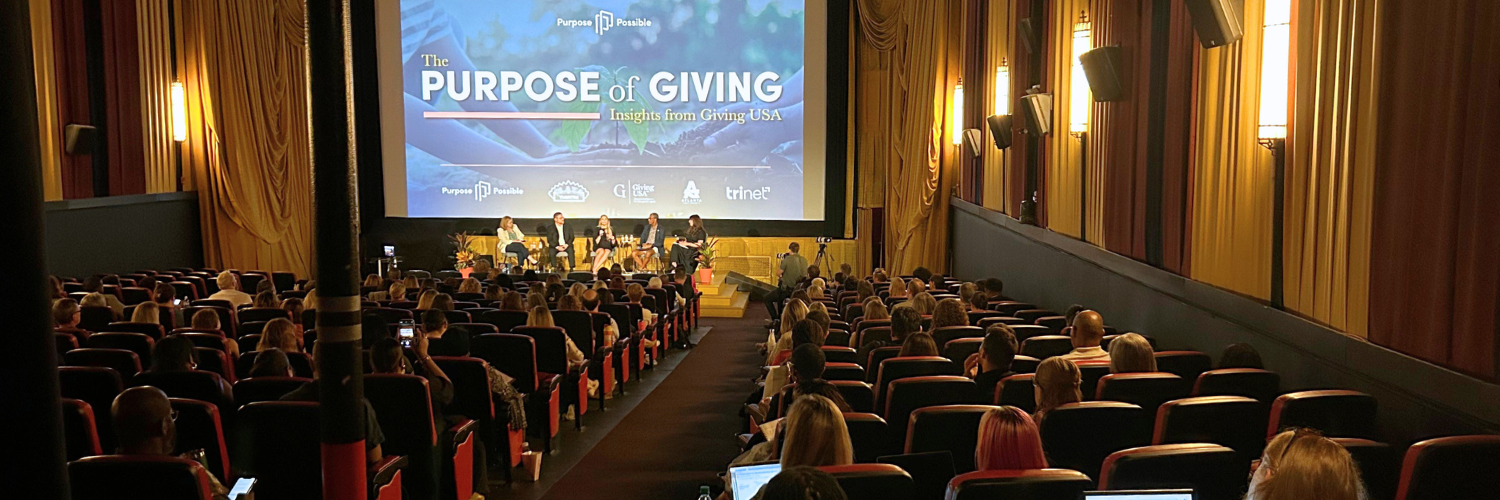2025 Purpose of Giving: Insights and Takeaways
Written by Rachel Stanley with Hannah Ranson & Tiffany Reed
On August 13, Purpose Possible and nearly 200 mission-driven professionals gathered and tuned in for The Purpose of Giving: Insights from Giving USA, a presentation and panel discussion on the latest findings from the 2025 Giving USA Annual Report on Philanthropy.
Featuring Ashley Collier, Chief Development Officer for Boys & Girls Clubs of Metro Atlanta; Rev. Tony Johns, Executive Director of Crossroads Atlanta; Laura MacDonald, Past Chair of the Giving USA Foundation and Founder of Benefactor Group; and Atiba Mbiwan, Executive Director of the Zeist Foundation and moderated by Laura Hennighausen, Director of Strategic Philanthropy at Purpose Possible, the event offered perspectives on trends shaping the philanthropic landscape in the United States.
Thank you to all who attended and shared questions and experiences. We hope these insights inspire your work and deepen your impact in the communities you serve.
Below are key highlights, actionable takeaways, and linked resources for organizations, professionals, and community builders looking to harness these insights and data. Giving USA Data Takeaways
Giving USA Data Takeaways
Overview:
Total Giving: In 2024, charitable giving reached $592.5 billion, representing a 6.3% increase over the previous year and exceeding the average growth rate of just under 6%.
Giving Vehicles: Growth in foundation giving continues. More and more individual donors, particularly high-net-worth donors, are giving through Donor-Advised Funds (DAFs) and closely held family foundations instead of direct gifts.
Sector Trends: The human services sector surpassed education in total giving. Religious giving remains the largest category but continues to decline in market share.
>> Many families modeled charitable giving for their children at religious institutions. With declines in religious attendance and giving, this early model for giving won’t reach as much of the next generation. How will they learn about giving?
Historical Trends: Charitable giving has declined only five times since 1967, with most declines occurring after significant tax law changes or economic crises. 2026 is likely to see significant changes in donor behavior because of the new tax law.
Individual Giving:
Individual giving remains the largest share of contributions and the primary driver of the charitable sector.
Donors continue to increase their gifts through non-cash methods, such as planned giving (bequests), Donor-Advised Funds (DAFs), and family foundations.
Monthly giving programs (as opposed to one-time gifts) are on the rise and have proven to be an effective donor retention strategy.
Generational Patterns: Donors born before 1964 demonstrate strong institutional loyalty, such as to religious institutions and schools, while younger generations are more motivated by causes than by institutional loyalty.
Wealth Transfer: An $18 trillion intergenerational wealth transfer is underway, but wealthy individuals tend to live long lives. The distribution of this wealth through planned giving or otherwise will likely be inequitable, favoring large nonprofits with dedicated staff to steward them.
DAF Rules: As DAFs rise in popularity, keep in mind the two primary restrictions on DAFs, they cannot be used to provide donor benefits (such as dinner at a fundraising gala) or to fulfill a binding pledge. “Intent to give” non-binding agreements can be a helpful workaround for donors interested in multi-year gifts.
Tax Law Impact: Federal tax law changes passed in July 2025 are likely to have a significant impact on donor behavior shortly.
Fewer taxpayers will be eligible to itemize their deductions. Additionally, deductions have a new cap for very high-income earners. This is likely to discourage individual giving beginning in 2026. Organizations may want to focus on major donors giving before the end of 2025.
With a new deduction of $1,000 for individuals and $2,000 for married couples filing jointly, mid-tier donors may increase their giving in 2026 and beyond.
Corporate Philanthropy:
Corporations currently give less than 1% of pre-tax profits, often through in-kind contributions.
Beginning next year, they will not be able to deduct the first 1% of profits given to charity; this is expected to reduce corporate giving by 4–8%.
Actionable Tips for Nonprofits
General Insights:
Messaging and Storytelling: Organizations should move from deficit-based messaging to highlighting strengths, solutions, and impact. Ensure that stories follow a clear arc from the starting state, through challenges and intervention, to an improved outcome. Use internal CRM data alongside national trends to make appeals more targeted and relevant.
Collaboration and Advocacy: Fundraisers should pursue intentional partnerships with other nonprofits, as funders increasingly value collaboration. Expand advocacy efforts to engage stakeholders in light of declining federal funding.
Individual Giving:
Encouraging donors who give close to $1,000 in 2026 is likely to be a helpful tactic. In an appeal, try asking them to donate by January 31, instead of December 31. (This applies to cash gifts, not DAF gifts.)
In contrast, encouraging major donors to give before the end of 2025 is wise.
Underused Opportunities: Employee matching gifts are significantly underutilized and should be incorporated into stewardship strategies. Make sure you’re checking with as many donors as possible about employee matching gift eligibility.
Corporate Giving:
Organizations should anticipate smaller corporate philanthropic budgets in 2026.
Fundraisers may want to connect with corporate partners to see if any grant deadlines can be moved up into the rest of 2025.
Additionally, in 2026, fundraisers may want to discuss marketing budgets, workforce development programs, and other business-related expenditures with corporate partners to counteract the impact of the new tax law.
Resources for Further Insight
Data presentation slides by Laura MacDonald
Giving USA 2025 | Benefactor Group
Charitable Giving is Resilient | Benefactor Group
How to Prepare for the Looming Changes in Corporate Giving | Benefactor Group
The Moles Always Win | Benefactor Group
The Tax Law’s Big Win for Charities Makes DAF Giving Trickier | Rasheeda Childress for The Chronicle of Philanthropy
The Tax Bill Will Upend Corporate Giving. Here’s How to Prepare | Laura MacDonald for The Chronicle of Philanthropy
Dr. Russell James (Texas Tech) – Research on generosity and donor psychology (LinkedIn)

